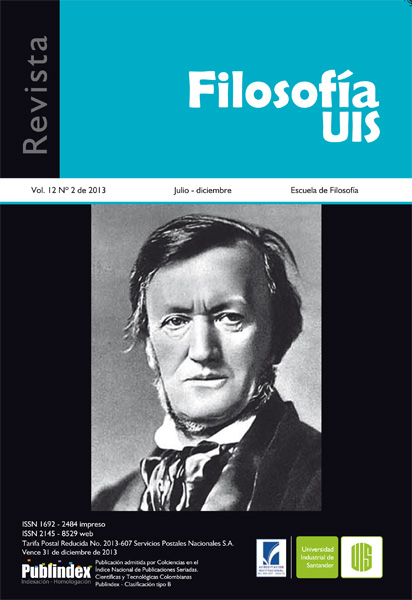Published 2013-12-03
Keywords
- aesthetics,
- body,
- proto-ethics,
- sensations
How to Cite
Copyright (c) 2013 Ana Constanza Rojas Latorre

This work is licensed under a Creative Commons Attribution 4.0 International License.
Abstract
Husserl begins his genetic phenomenology with the lessons of Thing and Space (1907) in which the concern by the body goes beyond of conceiving it as a material thing. The development of this idea is found in his unfinished Ideas II, where it sketches the role of the body with respect of material nature, mental and spirit. This paper shows the structure of the somatological proposal of Husserl and how it makes the body a foundation for the aesthetic experience, ethical basis of life and the constitution of culture and society.
Downloads
References
- Bernet, R. Figal, G. y Gander, H. (eds.) (2009). “Leiblichkeit bei Husserl und Heidegger”. Heidegger und Husserl: Neue Perspektive. Francfort: Klostermann, pp. 43-71.
- Gallagher, S. Bermúdez, J. et al. (ed.) (2001). “Body Schema and Intentionality”. Body and the Self. Massachusetts: MIT Press paperback, pp. 225-244.
- Husserl, E. (1962). Ideas relativas a una fenomenología pura y una filosofía fenomenológica I. México: Fondo de Cultura Económica.
- Husserl, E. (1994). Problemas fundamentales de la fenomenología. Madrid: Alianza.
- Husserl, E. (1997a). Thing and Space: Lectures of 1907. Dordrecht: Kluwer.
- Husserl, E. (1997b). Ideas relativas a una fenomenología pura y una filosofía fenomenológica II. México: Fondo de Cultura Económica / Universidad Nacional Autónoma de México.
- Husserl, E. (2000). Ideas relativas a una fenomenología pura y una filosofía fenomenológica III. México: Universidad Nacional Autónoma de México.
- Lotz, C. (2007). From Affectivity to Subjectivity: Husserl´s Phenomenology Revisited. Nueva York: Palcgrave MacMillan.
- San Martin, J. Rivera de Rosales, J. y López, M. (eds.) (2013). “Apuntes para una teoría fenomenológica del cuerpo”. El cuerpo: Perspectivas filosóficas. Madrid: UNED, pp. 133-164.
- Serrano de Haro, A. (1997). La posibilidad de la fenomenología: Fundamentos del análisis fenomenológico del cuerpo. Madrid: Complutense.
- Welton, D. (2006). “El mundo como horizonte trascendental”. La lámpara de Diógenes. Volumen 7. (12-13). pp. 98-113.
- Cibergrafía
- Canela, G. (2013). “El concepto fenomenológico de cinestesia y la correlación con las secuencias del campo visual: un análisis de las lecciones de Cosa y espacio de 1907”. Eikasia. (47), pp. 749-766. Recuperado de: http://www.revistadefilosofia. com/revista47.pdf Consultado el 3 de febrero de 2013.
